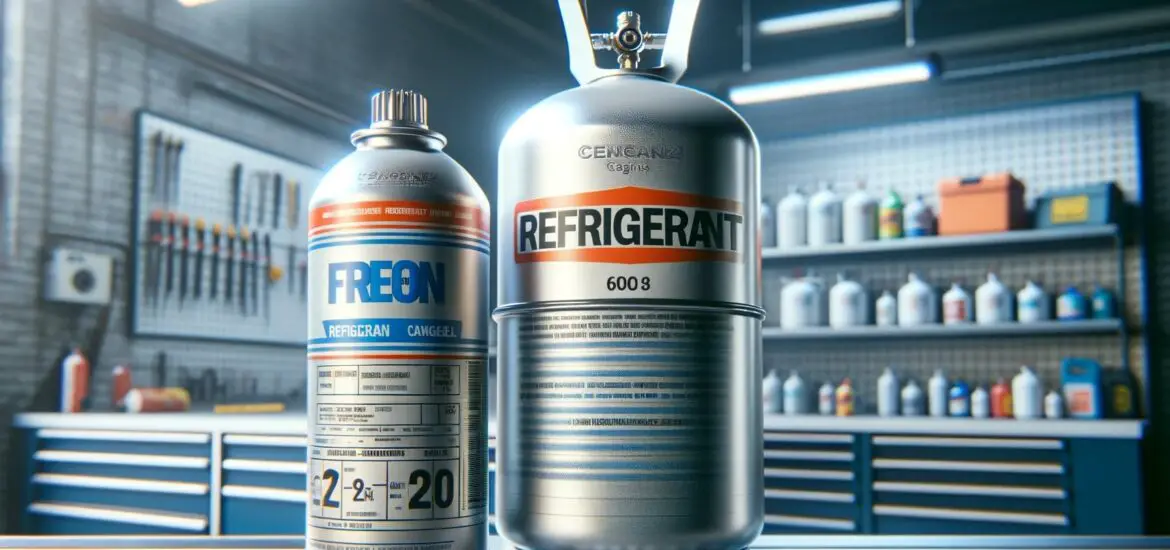What is the difference between refrigerant and freon? Find out in this comprehensive comparison guide.

Table of Contents
What is Refrigerant?
Refrigerants are chemical compounds vital to the functionality of air conditioning, refrigeration, and heat pump systems. They work on the principle of absorbing and releasing heat, which is essential for temperature regulation.
When inside the air conditioning system, the refrigerant absorbs heat from the indoor air, converting from a liquid to a gas. This gas is then compressed and circulated through the system to the outside unit. It then releases the absorbed heat before it is condensed back into a liquid. This process repeats, continuously moving heat from inside to outside, thus cooling the interior space.
There are different types of refrigerants, each with specific properties that make them suitable for particular applications. For instance, some refrigerants operate efficiently in high-temperature environments. On the other hand, others are better suited for low-temperature conditions. The choice of refrigerant also depends on factors like environmental impact, safety (flammability and toxicity), and system compatibility.
Examples of common refrigerants include R-22 (Chlorodifluoromethane), R-134a (Tetrafluoroethane), and R-410A, a blend of difluoromethane and pentafluoroethane.
What is Freon?
Freon, a trademarked brand by the Chemours company, refers to a specific set of refrigerants known for their use in older air conditioning and refrigeration systems. Freon became synonymous with all refrigerants due to its widespread use and market presence.
Historically, Freon products were made using chlorofluorocarbons (CFCs) and hydrochlorofluorocarbons (HCFCs). These products were later identified as significant contributors to ozone layer depletion.
The most commonly known Freon types are R-12, R-22, and R-134a, each with distinct chemical compositions and uses. R-12 was used in car air conditioning systems until it was phased out for environmental reasons. R-22 was common in home air conditioning systems.
With increasing environmental awareness and regulations, the use of Freon, particularly those with CFCs and HCFCs, has been significantly reduced. Newer and more environmentally friendly refrigerants have been developed to replace these harmful compounds. However, the term ‘Freon’ is still popularly used to refer to refrigerants in general, despite being a specific brand name.
Key Difference Between Refrigerant and Freon
The primary difference between ‘refrigerant’ and ‘Freon’ lies in their definitions and scope. ‘Refrigerant’ is a general term encompassing any chemical compound used in cooling and air conditioning systems. It includes a wide variety of chemicals with different properties and environmental impacts.
On the other hand, ‘Freon’ is a specific brand name that became a generic term for refrigerants but originally referred to specific products made by the Chemours company, mainly containing CFCs and HCFCs.
This distinction is crucial in understanding the environmental impact and regulatory compliance of air conditioning systems. Not all refrigerants are Freon, especially with the advent of newer, more eco-friendly compounds.
Freon, in its traditional sense, is associated with older refrigerants that are now being phased out due to their ozone-depleting characteristics. Hence, when discussing refrigerants, it’s important to differentiate between the broad range of compounds available and the specific, historically significant Freon products.
Environmental Impact and Regulations
The environmental impact of refrigerants, especially those used in the past like CFCs and HCFCs, has been a major concern. These compounds contribute to the depletion of the ozone layer, a crucial shield that protects the Earth from harmful ultraviolet radiation.
The realization of this impact led to the Montreal Protocol, an international treaty aimed at phasing out ozone-depleting substances. This treaty has been instrumental in reducing the use of harmful refrigerants and promoting the development of more environmentally friendly alternatives.
Regulations surrounding refrigerants now focus on minimizing their potential to cause global warming. The Global Warming Potential (GWP) of refrigerant measures its ability to trap heat in the atmosphere compared to carbon dioxide.
Refrigerants with a high GWP are being phased out in favor of those with lower GWP, to mitigate climate change. This shift has led to the innovation of refrigerants like hydrofluoroolefins (HFOs) and natural substances like ammonia, which have much lower environmental impacts.
Compliance with these environmental regulations is not only a matter of legal obligation but also a responsibility towards sustainable practices. It influences the manufacturing, servicing, and disposal of air conditioning and refrigeration equipment worldwide.
Choosing the Right Refrigerant for Your System
Selecting the appropriate refrigerant is crucial for the efficiency, legal compliance, and environmental impact of your air conditioning or refrigeration system. Factors to consider include the design and age of your system, the specific cooling requirements, and the legal and environmental regulations in your region.
Modern air conditioning systems are designed to be compatible with newer, eco-friendly refrigerants. However, older systems may still operate on now-phased-out Freon types. As such, they might require retrofitting or complete replacement to meet current standards.
It’s advisable to consult with HVAC professionals when choosing a refrigerant. They can provide insights into the most suitable options for your system, considering factors such as performance, cost, and environmental impact.
In addition, regular maintenance and proper handling of refrigerants are essential to ensure system efficiency and environmental safety.